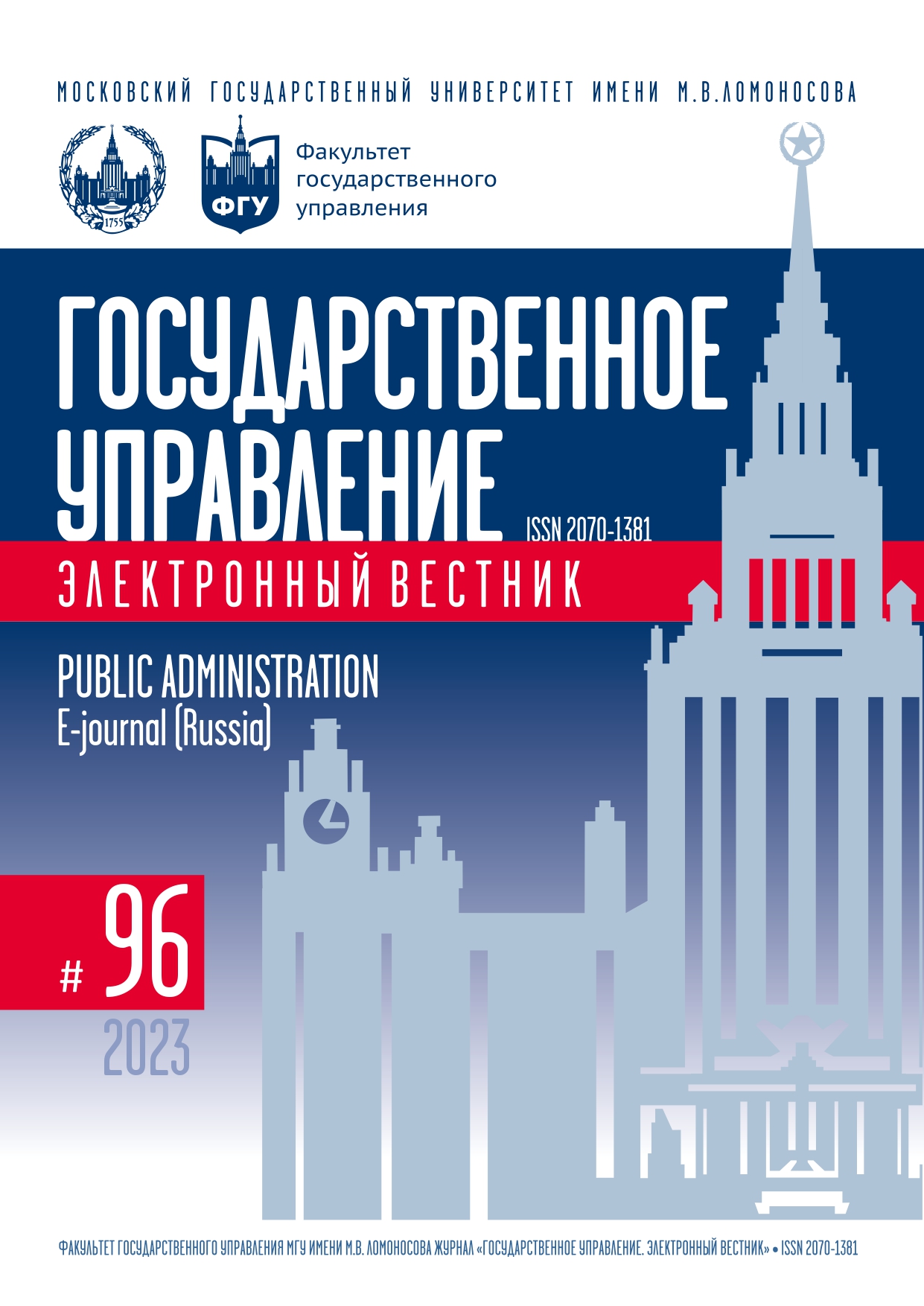Latent in Public Mechanisms: Flaws in Lobbying Regulation in the USA
Keywords:
Lobbying, lobbying mechanisms, state regulation, vetocracy, astroturfAbstract
The aim of the article is to identify the contradictory impact of lobbying as a public institution on public policy and administration at the sectoral and regional levels of a country with established market mechanisms and a system of state support. This study is based on an analysis of legal acts regulating lobbying activities both at the federal level and at the level of states and industries. The article shows that lobbying as an integral part of the functional representation of interests in the United States has turned into an institution of public administration with a developed regulatory framework. However, when analyzing in detail the mechanisms of its functioning at the level of industries and states, practices are revealed whose influence on public policy and administration significantly diverges from legal goal-setting. An example of an industry where lobbying practices play an important role is healthcare, which has developed market mechanisms combined with an advanced system of state support and regulation. In addition, it has been established that lobbying, even with its developed normative regulation, significantly distorts free political competition, when its practices lead to the reproduction of vetocracy, and also includes such political and administrative mechanisms as astroturf and taxpayer-funded lobbying. This is especially evident at the state level. The features of lobbying regulation that affect the socio-economic development of the region and its investment attractiveness are highlighted.
References
Белоусов А.Б. Современная практика лоббизма в США // Антиномии. 2013. № 2. С. 69–86.
Белоусов А.Б. Проблема вращающихся дверей в США: между лоббизмом и институциональной коррупцией // Актуальные проблемы научного обеспечения государственной политики Российской Федерации в области противодействия коррупции. 2018. № 1. С. 564–576. DOI: 10.17506/articles.anticorruption.2018.564576
Горовая Я.И., Кремянская Е.А. Лоббизм: его роль и влияние на механизм власти США // Право и управление. XXI век. 2022. №18(1). С. 63–72. DOI: 10.24833/2073-8420-2022-1-62-63-72
Зяблюк Н.Г. Лоббизм в США как политический институт // США: экономика, политика, идеология. 1995. № 1. С. 51–56.
Костяев С.С. Американские специалисты о системе здравоохранения в США // ЭСПР. 2020. № 3. С. 114–136. DOI: 10.31249/espr/2020.03.06
Кремянская Е.А. Правовые аспекты регулирования лоббизма в Соединенных штатах Америки и Канаде // Вестник МГИМО-Университета. 2014. № 2(35). С. 161–168. DOI: 10.24833/2071-8160-2014-2-35-161-168
Кугай А.И., Давыдов А.Б. Модели лоббистских практик в морской деятельности США и стран Европы // Управленческое консультирование. 2022. № 2. С. 20–32. DOI: 10.22394/1726-1139-2022-2-20-32
Левичева В.Ф. Институциональные и неформальные практики лоббизма: проблема разделения и интерпретации // Социологические исследования. 2021. № 10. С. 50–60. DOI: 10.31857/S013216250017165-4
Мельков С.А., Ножка С.М., Чумаченко А.П. Сравнительный анализ института лоббизма в России и США // Власть. 2018. № 5. С. 45–51. DOI: 10.31171/vlast.v26i5.5820
Павроз А.В. Институт лоббизма в современных демократических обществах // Политическая экспертиза: ПОЛИТЭКС. 2014. Т. 10. № 3. C. 158–169.
Руденкин В.Н. Лоббизм, группы интересов и коррупция в США // Вестник УИЭУиП. 2008. № 4(5). C. 76–92.
Хальфин Р.А., Таджиев И.Я. Организация здравоохранения в США. Часть 1 // Менеджер здравоохранения. 2012. № 9. C. 35–47.
Cluverius J. How the Flattened Costs of Grassroots Lobbying Affect Legislator Responsiveness // Political Research Quarterly. Vol. 70. Is. 2. 2017. P. 279–290.
Dincer O., Johnston M. Measuring Illegal and Legal Corruption in American States: Some Results from the Edmond J. Safra Center for Ethics Corruption in America Survey // Edmond J. Safra Working Papers. 2015. № 58. DOI: 10.2139/ssrn.2579300
Helmke G., Levitsky S. Informal Institutions and Comparative Politics: A Research Agenda // Perspectives on Politics. Vol. 2. Is. 4. 2004. P. 725–740. DOI: 10.1017/S1537592704040472
Holman C. Lobbying Reform in the United States and the European Union: Progress on Two Continents // Public Citizen. 2008.
URL: https://www.citizen.org/wp-content/uploads/lobbying-reform-in-the-us-eu.pdf
Kollmar L., Koen R. Lobbying against Democracy // Journal of Anti-Corruption Law. 2017. Vol. 1. Is. 1. P. 9–45.
Popiel P. The Tech Lobby: Tracing the Contours of New Media Elite Lobbying Power // Communication, Culture and Critique. 2018. Vol. 11. Is. 4. P. 566–585. DOI: 10.1093/ccc/tcy027
Sekar A., Williams E., Chen R. Changes in Time Use and Their Effect on Energy Consumption in the United States // Joule. 2018. Vol. 2. Is. 3. P. 521–536. DOI: 10.1016/j.joule.2018.01.003
Schpero W.L., Wiener T., Carter S., Chatterjee P. Lobbying Expenditures in the US Health Care Sector, 2000–2020 // JAMA Health Forum. 2022. Vol. 3. Is. 10. DOI: 10.1001/jamahealthforum.2022.3801
Spak M. America for Sale: When Well-Connected Former Federal Officials Peddle Their Influence to the Highest Foreign Bidder-A Statutory Analysis and Proposals for Reform of the Foreign Agents Registration Act and the Ethics in Government Act // Kentucky Law Journal. 1989. Vol. 78. Is. 2. P. 237–292.
Strickland J.M. The Declining Value of Revolving-Door Lobbyists: Evidence from the American States // American Journal of Political Science. 2020. Vol. 64. Is. 1. P. 67–81.
Thomas H., LaPira T. How Many Lobbyists Are in Washington? Shadow Lobbying and the Gray Market for Policy Advocacy // Interest Groups & Advocacy. 2017. Vol. 6. P. 199–214. DOI: 10.1057/s41309-017-0024-y
You H.Y. Foreign Agents Registration Act: A User’s Guide // Interest Groups & Advocacy. 2020. Vol. 9. P. 302–316. DOI: 10.1057/s41309-020-00100-1

